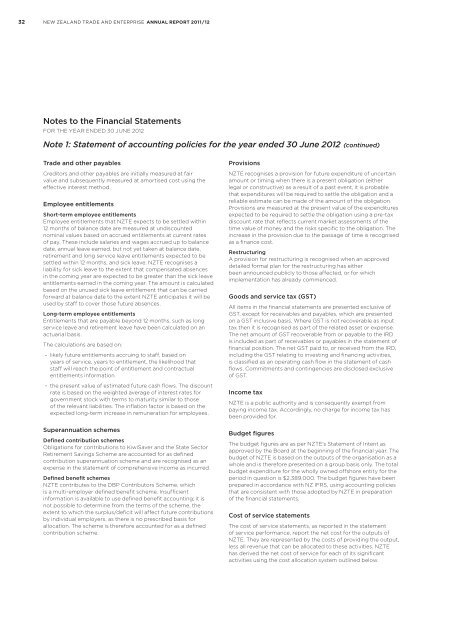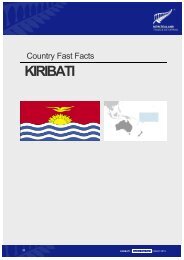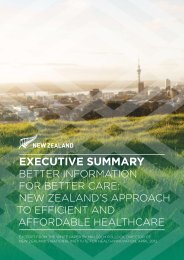Annual Report 2011 / 12 - New Zealand Trade and Enterprise
Annual Report 2011 / 12 - New Zealand Trade and Enterprise
Annual Report 2011 / 12 - New Zealand Trade and Enterprise
You also want an ePaper? Increase the reach of your titles
YUMPU automatically turns print PDFs into web optimized ePapers that Google loves.
32<br />
NEW ZEALAND TRADE AND ENTERPRISE ANNUAL REPORT <strong>2011</strong>/<strong>12</strong><br />
Notes to the Financial Statements<br />
FOR THE YEAR ENDED 30 JUNE 20<strong>12</strong><br />
Note 1: Statement of accounting policies for the year ended 30 June 20<strong>12</strong> (continued)<br />
<strong>Trade</strong> <strong>and</strong> other payables<br />
Creditors <strong>and</strong> other payables are initially measured at fair<br />
value <strong>and</strong> subsequently measured at amortised cost using the<br />
effective interest method.<br />
Employee entitlements<br />
Short-term employee entitlements<br />
Employee entitlements that NZTE expects to be settled within<br />
<strong>12</strong> months of balance date are measured at undiscounted<br />
nominal values based on accrued entitlements at current rates<br />
of pay. These include salaries <strong>and</strong> wages accrued up to balance<br />
date, annual leave earned, but not yet taken at balance date,<br />
retirement <strong>and</strong> long service leave entitlements expected to be<br />
settled within <strong>12</strong> months, <strong>and</strong> sick leave. NZTE recognises a<br />
liability for sick leave to the extent that compensated absences<br />
in the coming year are expected to be greater than the sick leave<br />
entitlements earned in the coming year. The amount is calculated<br />
based on the unused sick leave entitlement that can be carried<br />
forward at balance date to the extent NZTE anticipates it will be<br />
used by staff to cover those future absences.<br />
Long-term employee entitlements<br />
Entitlements that are payable beyond <strong>12</strong> months, such as long<br />
service leave <strong>and</strong> retirement leave have been calculated on an<br />
actuarial basis.<br />
The calculations are based on:<br />
– likely future entitlements accruing to staff, based on<br />
years of service, years to entitlement, the likelihood that<br />
staff will reach the point of entitlement <strong>and</strong> contractual<br />
entitlements information<br />
– the present value of estimated future cash flows. The discount<br />
rate is based on the weighted average of interest rates for<br />
government stock with terms to maturity similar to those<br />
of the relevant liabilities. The inflation factor is based on the<br />
expected long-term increase in remuneration for employees.<br />
Superannuation schemes<br />
Defined contribution schemes<br />
Obligations for contributions to KiwiSaver <strong>and</strong> the State Sector<br />
Retirement Savings Scheme are accounted for as defined<br />
contribution superannuation scheme <strong>and</strong> are recognised as an<br />
expense in the statement of comprehensive income as incurred.<br />
Defined benefit schemes<br />
NZTE contributes to the DBP Contributors Scheme, which<br />
is a multi-employer defined benefit scheme. Insufficient<br />
information is available to use defined benefit accounting; it is<br />
not possible to determine from the terms of the scheme, the<br />
extent to which the surplus/deficit will affect future contributions<br />
by individual employers, as there is no prescribed basis for<br />
allocation. The scheme is therefore accounted for as a defined<br />
contribution scheme.<br />
Provisions<br />
NZTE recognises a provision for future expenditure of uncertain<br />
amount or timing when there is a present obligation (either<br />
legal or constructive) as a result of a past event, it is probable<br />
that expenditures will be required to settle the obligation <strong>and</strong> a<br />
reliable estimate can be made of the amount of the obligation.<br />
Provisions are measured at the present value of the expenditures<br />
expected to be required to settle the obligation using a pre-tax<br />
discount rate that reflects current market assessments of the<br />
time value of money <strong>and</strong> the risks specific to the obligation. The<br />
increase in the provision due to the passage of time is recognised<br />
as a finance cost.<br />
Restructuring<br />
A provision for restructuring is recognised when an approved<br />
detailed formal plan for the restructuring has either<br />
been announced publicly to those affected, or for which<br />
implementation has already commenced.<br />
Goods <strong>and</strong> service tax (GST)<br />
All items in the financial statements are presented exclusive of<br />
GST, except for receivables <strong>and</strong> payables, which are presented<br />
on a GST inclusive basis. Where GST is not recoverable as input<br />
tax then it is recognised as part of the related asset or expense.<br />
The net amount of GST recoverable from or payable to the IRD<br />
is included as part of receivables or payables in the statement of<br />
financial position. The net GST paid to, or received from the IRD,<br />
including the GST relating to investing <strong>and</strong> financing activities,<br />
is classified as an operating cash flow in the statement of cash<br />
flows. Commitments <strong>and</strong> contingencies are disclosed exclusive<br />
of GST.<br />
Income tax<br />
NZTE is a public authority <strong>and</strong> is consequently exempt from<br />
paying income tax. Accordingly, no charge for income tax has<br />
been provided for.<br />
Budget figures<br />
The budget figures are as per NZTE’s Statement of Intent as<br />
approved by the Board at the beginning of the financial year. The<br />
budget of NZTE is based on the outputs of the organisation as a<br />
whole <strong>and</strong> is therefore presented on a group basis only. The total<br />
budget expenditure for the wholly owned offshore entity for the<br />
period in question is $2,389,000. The budget figures have been<br />
prepared in accordance with NZ IFRS, using accounting policies<br />
that are consistent with those adopted by NZTE in preparation<br />
of the financial statements.<br />
Cost of service statements<br />
The cost of service statements, as reported in the statement<br />
of service performance, report the net cost for the outputs of<br />
NZTE. They are represented by the costs of providing the output,<br />
less all revenue that can be allocated to these activities. NZTE<br />
has derived the net cost of service for each of its significant<br />
activities using the cost allocation system outlined below.
















